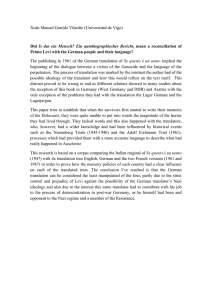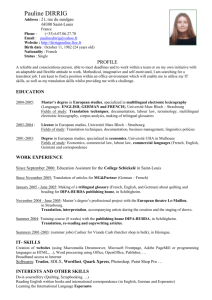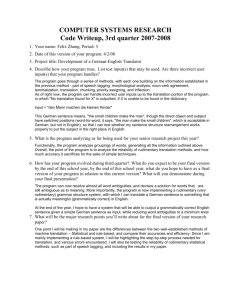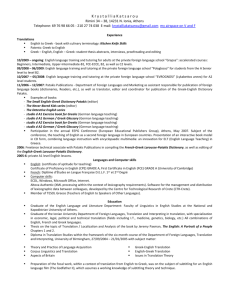Translation and the language(s) of medicine: Keys to
advertisement
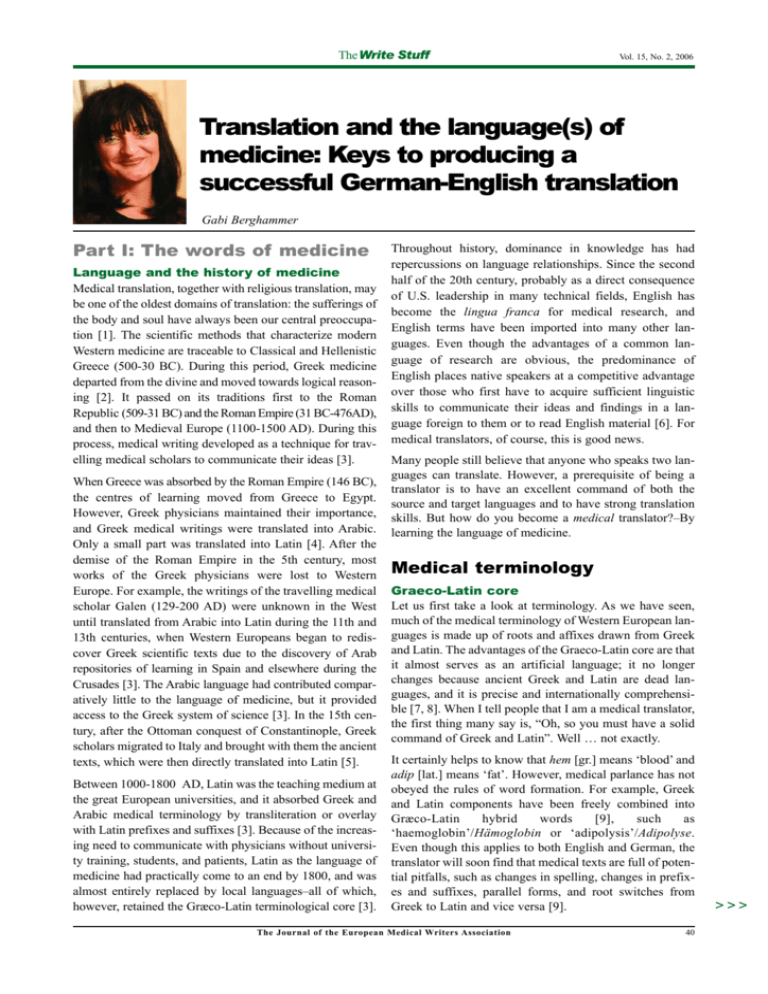
TheWrite Stuff Vol. 15, No. 2, 2006 Translation and the language(s) of medicine: Keys to producing a successful German-English translation Gabi Berghammer Part I: The words of medicine Language and the history of medicine Medical translation, together with religious translation, may be one of the oldest domains of translation: the sufferings of the body and soul have always been our central preoccupation [1]. The scientific methods that characterize modern Western medicine are traceable to Classical and Hellenistic Greece (500-30 BC). During this period, Greek medicine departed from the divine and moved towards logical reasoning [2]. It passed on its traditions first to the Roman Republic (509-31 BC) and the Roman Empire (31 BC-476AD), and then to Medieval Europe (1100-1500 AD). During this process, medical writing developed as a technique for travelling medical scholars to communicate their ideas [3]. When Greece was absorbed by the Roman Empire (146 BC), the centres of learning moved from Greece to Egypt. However, Greek physicians maintained their importance, and Greek medical writings were translated into Arabic. Only a small part was translated into Latin [4]. After the demise of the Roman Empire in the 5th century, most works of the Greek physicians were lost to Western Europe. For example, the writings of the travelling medical scholar Galen (129-200 AD) were unknown in the West until translated from Arabic into Latin during the 11th and 13th centuries, when Western Europeans began to rediscover Greek scientific texts due to the discovery of Arab repositories of learning in Spain and elsewhere during the Crusades [3]. The Arabic language had contributed comparatively little to the language of medicine, but it provided access to the Greek system of science [3]. In the 15th century, after the Ottoman conquest of Constantinople, Greek scholars migrated to Italy and brought with them the ancient texts, which were then directly translated into Latin [5]. Between 1000-1800 AD, Latin was the teaching medium at the great European universities, and it absorbed Greek and Arabic medical terminology by transliteration or overlay with Latin prefixes and suffixes [3]. Because of the increasing need to communicate with physicians without university training, students, and patients, Latin as the language of medicine had practically come to an end by 1800, and was almost entirely replaced by local languages–all of which, however, retained the Græco-Latin terminological core [3]. Throughout history, dominance in knowledge has had repercussions on language relationships. Since the second half of the 20th century, probably as a direct consequence of U.S. leadership in many technical fields, English has become the lingua franca for medical research, and English terms have been imported into many other languages. Even though the advantages of a common language of research are obvious, the predominance of English places native speakers at a competitive advantage over those who first have to acquire sufficient linguistic skills to communicate their ideas and findings in a language foreign to them or to read English material [6]. For medical translators, of course, this is good news. Many people still believe that anyone who speaks two languages can translate. However, a prerequisite of being a translator is to have an excellent command of both the source and target languages and to have strong translation skills. But how do you become a medical translator?–By learning the language of medicine. Medical terminology Graeco-Latin core Let us first take a look at terminology. As we have seen, much of the medical terminology of Western European languages is made up of roots and affixes drawn from Greek and Latin. The advantages of the Graeco-Latin core are that it almost serves as an artificial language; it no longer changes because ancient Greek and Latin are dead languages, and it is precise and internationally comprehensible [7, 8]. When I tell people that I am a medical translator, the first thing many say is, “Oh, so you must have a solid command of Greek and Latin”. Well … not exactly. It certainly helps to know that hem [gr.] means ‘blood’ and adip [lat.] means ‘fat’. However, medical parlance has not obeyed the rules of word formation. For example, Greek and Latin components have been freely combined into Græco-Latin hybrid words [9], such as ‘haemoglobin’/Hämoglobin or ‘adipolysis’/Adipolyse. Even though this applies to both English and German, the translator will soon find that medical texts are full of potential pitfalls, such as changes in spelling, changes in prefixes and suffixes, parallel forms, and root switches from Greek to Latin and vice versa [9]. The Journal of the European Medical Writers Association 40 >>> Vol. 15, No. 2, 2006 TheWrite Stuff > > > Translation and the language(s) of medicine Changes in spelling Transliteration of Greek and Latin letters has not always resulted in the same spelling in English and German [9]. For example, the English ‘haematopoiesis’ becomes Hämatopoese in German, dropping the ‘i’ from ‘-poiesis’. The same is true for ‘ovariectomy’, which is Ovarektomie in German. Conversely, German adds an ‘i’ to ‘hypokalaemia’ and turns it into Hypokaliämie. Why then, are ‘hypocalcaemia’ and Hypokalzämie spelt the same? The English ‘quinone’ is Chinon in German, and ‘suggillation’ loses its first double letter and becomes Sugillation in German. Parallel forms Another pitfall awaits the translator when a term in one language has several equivalents in the other. For example, to translate the English ‘metabolism’, German offers both Metabolismus and Metabolisierung. However, the two are not interchangeable. Metabolismus, or Stoffwechsel, refers to the chemical processes occurring within a living cell or organism that are necessary for the maintenance of life, whereas Metabolisierung, or Biotransformation, refers to the chemical alterations of a compound which occur within the body to excrete this compound. Changes in affixes The challenge in translating prefixes is that they do not always tally in English and German [9]. For example, the English ‘constipation’ becomes Obstipation in German, ‘disinfection’ becomes Desinfektion, and ‘intestinal absorption’ is intestinale Resorption. In English, ‘disassimilation’ and ‘dissimilation’ are used synonymously, whereas German uses only Dissimilation. Terms from common speech Another characteristic of medical terminology is that it consists of numerous words from everyday speech whose basic meaning has been extended to medical uses [9]. The challenge for the translator is to spot these terms as having a specific medical meaning. The same for suffixes. Thus, the English ‘cholesterol’ is Cholesterin in German. The German translation of ‘pulmonary artery’ is Pulmonalarterie, whereas ‘tubal pregnancy’ becomes Tubargravidität. ‘Thymic leukaemia’ is thymogene Leukämie in German, but the English ‘lymphogenous leukaemia’ becomes lymphatische Leukämie. And ‘disinfected’ is desinfiziert (Figure 1). Switches in Greek or Latin roots Not only affixes are handled differently in English and German [9]. Sometimes a Greek root in one language gives way to Latin, and vice versa. For example, the English ‘mastadenoma’, a term based on the Greek root mast for ‘breast’, becomes Mammaadenom in German, a term based on the Latin root mamma. The English ‘oocyte’ [gr.] has both a Greek and a Latin equivalent in German, i.e. Oozyt and Ovozyt [lat.]. The German Hypertonie [gr.] is ‘hypertension’ [lat.] in English. Conversely, the English ‘pituitary’ [lat.] is hypophysär [gr.] in German. In English, ‘seminuria’ [lat.] and ‘spermaturia’ [gr.] exist side by side, whereas German uses only Spermaturie. The same is true for the English doublets ‘venesection’ [lat.] and ‘phlebotomy’ [gr.], which is Phlebotomie in German. Figure 1. Text on a plastic bag I picked up in the bathroom of a Maltese hotel in May 2005, during the EMWA Conference. I seriously doubt that the glass wrapped up in this plastic bag really was disinfected, but that's not the point. Please consider the English-German translation: a pitfall fallen into. A well-known common-speech word with a specific medical meaning is ‘history’, referring to the time before the patient’s introduction to medical care, and its German equivalent Krankengeschichte. An interesting use of language is the phrase ‘past medical history’. In common speech, ‘past history’ would appear redundant. In a medical context, however, ‘past medical history’ has a specific meaning, referring to the history of previous illnesses as opposed to the ‘history of the present illness’, terms that may be translated into German as Vorgeschichte früherer Krankheiten and Vorgeschichte der augenblicklichen Erkrankung. Another example is the word ‘tender’, whose medical meaning differs somewhat from its meaning in everyday language. In medicine it has nothing to do with being kind and loving but is used to refer to the feeling of pain when touched. A possible German translation is druckempfindlich. English terms adopted in German As the influence of Greek and Latin on the language of medicine shows, it is sometimes easier to borrow foreign terms together with the science. In line with the predominance of English in science, medical German is full of terms imported from English, such as Compliance, which may (but perhaps should not) be rendered in German as something like die Bereitschaft des Patienten zur aktiven Mitwirkung an therapeutischen Maßnahmen. Other English terms may have a German equivalent, such as first-pass effect, in German First-pass-Effekt, which could also be rendered as Effekt der 1. Leberpassage, or Acute Respiratory Distress Syndrome, which translates as Schocklunge or akutes Lungenversagen, but German usage often prefers the English over the German term. Many English terms adopted in German do not even have a German equivalent, such as Face lifting, Intent-to-treat, Surfactant, or Restless-Legs-Syndrom, to name only a very few. 41 The Journal of the European Medical Writers Association TheWrite Stuff Vol. 15, No. 2, 2006 Translation and the language(s) of medicine False friends False friends cause difficulty not only in our personal lives, but also in the life of the translator. False friends are word pairs that look like they might mean the same thing in both languages but don’t. Some examples that immediately come to mind are ‘drug’ (Arzneimittel) and Droge (addictive drug), ‘ambulance’ (Krankenwagen) and Ambulanz (outpatient department), ‘gift’ (Geschenk) and Gift (poison), ‘pregnant’ (schwanger) and prägnant (succinct), or ‘preservative’ (Konservierungsmittel) and Präservativ (condom). A perhaps less obvious but potentially dangerous example is the English term ‘narcotics’, a false friend of the German Narkotika. Thus, ‘narcotics’ and its synonyms ‘opioids’ or ‘narcotic analgesics’ translate into German as Opioide or Opioid-Analgetika. The German term Narkotika is synonymous with Allgemeinanästhetika and translates as ‘general anaesthetics’. Synonyms Speaking of synonyms–‘medspeak’ is full of concepts that go under several names which are basically equivalent but may differ according to whether they derive from anatomical, pathogenic, historical, or descriptive considerations [9]. For example, ‘accessory mamma’ is the name given to the presence of more than one pair of breasts, also referred to as ‘supernumerary mamma’, ‘mamma accessoria’, ‘polymastia’, and ‘hypermastia’. German equivalents are akzessorische Mamma, Mamma accessoria, Polymastie, and Hypermastie. One of these terms, i.e. ‘hypermastia’/Hypermastie, also applies to a second concept, i.e. oversize of the breasts, and is synonymous with ‘macromastia’ in English and Mammahypertrophie in German. But beware–‘macromastia’ is, of course, not synonymous with ‘polymastia’. Also, for many learned terms, both English and German have a synonym in everyday speech, such as ‘haemorrhage’/’bleeding’ and Hämorrhagie/Blutung, ‘myopia’/’shortsightedness’ and Myopie/Kurzsichtigkeit, or ‘pruritus’/’itching’ and Pruritus/Juckreiz. Which of these synonyms is used in writing and translation will depend on the genre or type of text to be translated and on the needs and expectations of its audience. Eponyms Eponyms are terms adapted from names of famous scientists. Sometimes, the same eponyms are used in both languages, such as ‘Wolff-Parkinson-White syndrome’. Alternatively, an eponym in one language may have a noneponymic equivalent in the other, such as the German Budd-Chiari-Syndrom, which translates as ‘venous occlusive disease’. Also, an eponym in one language may correspond to another eponym in the other language, as is the case for ‘Henderson-Jones syndrome’, which is ReichelSyndrom in German. To complicate matters further, some eponyms are synonymous, such as ‘Basedow’s disease’, ‘Graves’ disease’, and ‘Flajani’s disease’. In German, the only synonym for Basedow-Krankheit is Morbus Basedow. Conversely, the same eponym may apply to different disorders, such as ‘Paget disease’/Paget-Krankheit, which applies to three distinct conditions: osteitis deformans, carcinoma of the breast, or carcinoma in the anogenital region. Of course, each of these concepts again has a number of synonyms of their own. Abbreviations and acronyms The fast growth of scientific knowledge in the past half century has generated great numbers of new terms, particularly multiterm words, such as ‘chronic obstructive pulmonary disease’ or ‘gonadotropin-releasing hormone’. Limited journal space and the disinclination to repeat long terms have led to frequent coinages of both abbreviations and acronyms (i.e. abbreviations formed from the initial letters of a compound term serving as pronounceable words). Thus, the above terms are often simply referred to as COPD and GnRH. Many abbreviations will not pose a problem to the translator because they are the same in both languages, such as GTT (‘glucose tolerance test’–Glukosetoleranztest) or SLE (‘systemic lupus erythemathosus’–systemischer Lupus erythematodes). However, what the translator should know is that German often simply adopts the English abbreviation. Thus, even though ‘chronic obstructive pulmonary disease’ translates as chronisch-obstruktive Lungenerkrankung, the abbreviation used in German is COPD, and the hormone Gonadoliberin may even be better known by its English abbreviation GnRH. Alternatively, a German author may prefer to use the abbreviation ASS for Acetylsalicylsäure, KHK for koronare Herzkrankheit, and BKS for Blutkörperchensenkung. The English equivalents of these abbreviations are ASA (‘acetylsalicylic acid’), CHD (‘coronary heart disease’), and ESR (‘erythrocyte sedimentation rate’). Names of active substances Drug names can present problems during translation because different countries may have different approved names. In most cases, national names are the same as the recommended International Non-proprietary Names (rINNs) introduced in the 1960s by the WHO. In other cases, the national and international names are similar, with only trivial differences, such as the British ‘cyclosporine’ and the international ‘ciclosporine’. Other examples of substances whose British Approved Names (BANs) differ from the rINNs include the anticancer drug ‘mitoxantrone’, which was converted to ‘mitozantrone’ because it was considered too similar to the proprietary name of the anticancer agent ‘Mitoxana’. Also, the BAN for the loop diuretic ‘frusemide’ differs from the rINN ‘furosemide’ because of potential confusion with ‘furamide’ [10]. In some cases, however, the national names are significantly different from the INNs. Among these are the sympathomimetics ‘adrenaline’ (epinephrine) and ‘noradrenaline’ (norepinephrine) or the local anaesthetics ‘amethocaine’ (tetracaine) and ‘lignocaine’ (lidocaine). The European Community therefore issued a directive in 1992, decreeing The Journal of the European Medical Writers Association 42 >>> TheWrite Stuff Vol. 15, No. 2, 2006 > > > Translation and the language(s) of medicine that in member countries the rINN should be used exclusively [11]. Despite harmonization on a European level, there are also a number of United States Adopted Names that differ from rINNs, such as ‘isoproterenol’ (INN: isoprenaline), ‘acetaminophen’ (paracetamol), or ‘meperidone’ (pethidine). Nomenclatures and classifications There is yet another characteristic of medical terminology, one which tries to bring order to the chaos of synonyms, eponyms, and acronyms. The precision of ‘medspeak’ is greatly increased by the use of nomenclatures, such as the WHO list of rINNs or the Paris Nomina Anatomica (PNA) and its latest version, the International Nomina Anatomica (INA), and classifications, such as the International Classification of Diseases (ICD), mainly used for coding diseases in hospitals and practices, or the Medical Dictionary for Regulatory Activities (MedDRA). All of these have one common purpose: to agree on a single term for any one organ, disease, or treatment. For example, the rules of the PNA were that each organ should have only one term, the terms should derive from Latin, and eponyms should be avoided [8]. Important as it may be for translators to get their terminology right–synonyms, eponyms, and acronyms are not enough to produce a readable and meaningful text. There is yet another aspect to translation–one that requires a curious and questioning mind. Part II: Beyond words Medical phraseology We have so far looked only at medical language on the level of individual words. Yet medical jargon is full of sequences of words and idioms which may sound unusual in everyday speech. For example, most case reports open with a standard sentence, such as “A 56-year-old white man presented to the emergency department with a chief complaint of nausea and vomiting”. The report may go on to say that “His past medical history was significant for…” and finally that “He was discharged home in good condition”. Thus, a case report is strongly conventional in style [12]. The target language also has its conventions. For example, “The postoperative course was uneventful” may be translated as Der postoperative Verlauf war unauffällig. You would never think of translating ‘uneventful’ literally as ereignislos. Convention determines which phrases are used to describe a particular medical situation or procedure. In contrast to case reports, which are similar in style and form wherever Western medicine is taught [12], clinical reports differ considerably when written by a doctor in Germany or in the United States [13]. For example, the cryptic phrase taken from an American ‘review of systems’ (Organanamnese), ‘Gen: Ø Hx: wt D/dizziness’, could be translated as Allgemeines: Keine Vorgeschichte von Gewichtsveränderungen oder Schwindel. As this example demonstrates, style patterns should not always be translated into the target language. 43 Convention may also determine whether the learned or the standard term is used. For example, where English speaks of ‘nausea and vomiting’, a combination of a Latin-based and a common-speech term, German uses either the LatinGreek combination Nausea und Emesis or the commonspeech phrase Übelkeit und Erbrechen. To change or omit these standard phrases is to fail to adhere to the conventions of the target text, making it sound less professional and perhaps even compromising its scientific credibility [14]. Terminology and phraseology –enough to produce a successful translation? Translation requires more than exchanging terms or phrases in one language for another, adhering to the rules of grammar, and choosing the appropriate register. Because language is closely linked to subject-matter knowledge [13], translators must know the subject they are addressing, not only to successfully master translation problems, but to, first of all, be aware of and identify potential pitfalls [15], some of which have been highlighted above. The text genres a medical translator is most likely to work in include study protocols, clinical reports, package inserts, biomedical articles, monographs, commercial brochures, and patient education material. All of these genres differ in terms of their function and purpose, their ‘whats’ and ‘whys’, their audiences, and the expectations of these audiences [16]. The translator must have a full understanding of both the source and the target text, and of what the author intends to say and what the recipient needs to hear. In this sense, every translation is a sort of interpretation [17], and even a seemingly minor misinterpretation and mistranslation, e.g. in a package insert, can have serious practical consequences. An impressive example of how mistranslation can distort what an author intends to say–and what the reader needs to hear–is the English translation of the writings of Freud. Bruno Bettelheim, in his book entitled ‘Freud and Man’s Soul’, argues that “the English translations of Freud’s writings are seriously defective” and have led to misperceptions about both Freud and psychoanalysis [18]. Considering that Freud himself stated that he considered the cultural and human significance of psychoanalysis more important than its medical one, why discuss this in the context of medical translation? Because of the translators’ preference for medical and learned terms over the common-speech words Freud had used, psychoanalysis came to be perceived, in the United States, as a medical specialty instead of the humanistic undertaking that Freud had had in mind. Freud’s greatest concern was with man’s inner being, to which he referred to as the ‘soul’ (Seele, from ‘psyche’ [gr.]). The purpose of his writings was to help his readers understand themselves so they could act more rationally. Language was an essential aspect of Freud’s work. He tried to communicate his concepts in words which his readers had used since their childhood, and he avoided technical and Græco-Latin terms whenever possible. The Journal of the European Medical Writers Association TheWrite Stuff Vol. 15, No. 2, 2006 Translation and the language(s) of medicine tion, it allows readers to distance themselves from what Freud tried to say. Psychoanalysis becomes, in translation, something that analyzes the unconscious of another person, but not our own. As a result, in the United States, the main task of psychoanalysis is to cure mental illness, and psychoanalysis is considered the prerogative of physicians. However, Freud, himself a physician, considered psychoanalysis a part of psychology. Freud’s goal for his readers was a reasonable dominance of our conSigmund Freud scious over our unconscious. The prime A particularly striking example is the way two of Freud’s requirement for living well, according to Freud, is to control most important concepts were translated into English. Freud our inner conflicts and to love and be loved–and not–as divided the soul into the conscious, the preconscious, and the many have erroneously assumed–to enable our ‘ego’ to build unconscious. To name these concepts, he chose words used a more satisfying life for itself. by every German-speaking child: To refer to the conscious aspects of the mind, he chose the personal pronoun ich (‘I’), Bruno Bettelheim aptly sums up the translator’s responsiand to refer to the unconscious, he chose the pronoun es bility: “Translators need to be very sensitive not only to what is written but also to what is implied. Their task very (‘it’). These personal pronouns were translated into English definitely includes an obligation to try to transmit not just using their Latin equivalents–the ‘ego’ and the ‘id’, turning the words forming a sentence but also the meanings to them into impersonal and technical speech. No word has which these words allude [18]”. Overall, therefore, the keys more intimate connotations than the pronoun ‘I’. In contrast, to producing a successful translation are “a love of lan‘ego’ has the connotation of selfishness, such as in ‘ego trip’, guage, an ear for style, a willingness to pursue arcane termiwhich was not what Freud had in mind. nology, and caring enough to get it exactly right [14]”. A major shortcoming of the English translations is that they eliminate any mention of the ‘soul’, which is substituted Gabi Berghammer with ‘mind’ throughout the translation. As we have seen, Vienna, Austria gabi@the-text-clinic.com for Freud the mind (Ich, or ‘I’) is only one of three aspects of our soul, the other two being the preconscious (Über-ich, References: 1. Van Hoof H. Histoire de la traduction médicale en occident. CILL, 1993. 19: p. 1-2. or ‘above-I’) and the unconscious (Es, or ‘it’). Therefore, 2. U.S. National Library of Medicine, Greek Medicine. "I swear by Apollo Physician...:" Greek Medicine from the Gods to Galen. what Freud referred to as the soul, the translators reduced http://www.nlm.nih.gov/hmd/greek/greek_intro.html, 2002. entirely to the conscious aspect of the mind, the ‘I’. 3. McMorrow L. Breaking the Greco-Roman Mold in Medical Writing: The His translators, Bettelheim contends, tended to replace words in ordinary use with medical terms and borrowings from Greek and Latin. One example of the translators’ preference for medical terms is the translation of Die Zerlegung der Psychischen Persönlichkeit. Bettelheim suggests a literal translation, such as ‘The Taking Apart of the Psychic Personality’. In English translation, this is rendered as ‘The Anatomy of the Mental Personality’. Nothing in the original suggests the translation Zerlegung as ‘anatomy’. Freud describes a number of errors we sometimes make in everyday life when our unconscious plays tricks on us, and he calls these Fehlleistungen. This term combines two well-known German nouns: Leistung means accomplishment, and Fehl- indicates failure. Thus, the word Fehlleistung combines an achievement and a mistake. For example, when we produce a Freudian slip of the tongue, we might feel that we said what we wanted to say, but we also know it was the wrong thing to say. One possible rendering of Fehlleistung, Bettelheim suggests, is ‘faulty achievement’. In English, Fehlleistung is translated as ‘parapraxis’, a word drawn from Greek. In German, we might readily say, “This was a Fehlleistung”, whereas the word ‘parapraxis’ sounds like something that is far removed from our own personal experience. Let me mention one more example amongst many others. What Freud referred to as Schaulust–a pleasure in watching something–may be difficult to translate, but a phrase such as ‘lust in looking’ would make his meaning clear. The word used by Freud’s translators–‘scopophilia’–does not. 4. 5. 6. 7. 8. 9. 10. 11. 12. 13. 14. 15. 16. 17. Overall, the English translation of Freud changed his message in significant ways. By making ample use of abstrac- 18. Many Languages of 20th Century Medicine. American Translators Association Scholarly Monograph Series, 1998. X: p. 13-27. Crombie AC. Medieval and Early Modern Science. 1967, Cambridge: Harvard University Press. Rosdolky M. History of Medicine Part I - Brief Review of Medical History. ATA Caduceus, 2004. Spring: p. 4-8. Liessmann KP. Platz für die Elite!, in Die Presse. 2006: Vienna, Austria. p. 1-2 Fluck H-R.,Fachsprachen. 1985, Tübingen: Franke Verlag GmbH. Rosdolky M. History of Medicine Part II - Medical Nomenclatures and Classification Systems. ATA Caduceus, 2004. Summer. Van Hoof H. The Language of Medicine: A Comparative Ministudy of English and French. American Translators Association Scholarly Monograph Series, 1998. X: p. 49-65. George CF. Naming of drugs: pass the epinephrine, please. BMJ 1996;312(7042):1315-6 Aronson JK. "Where name and image meet" - the argument for "adrenaline". BMJ 2000; 320(7233):506-9. Hunter KM. Doctor's Stories. The Narrative Structure of Medical Knowledge. 1991, Princeton: Princeton University Press. Lee-Jahnke H. Training in Medical Translation with Emphasis on German. American Translators Association Scholarly Monograph Series, 1998. X: p. 81-91. O'Neill M. Who Makes a Better Medical Translator: The Medically Knowledgeable Linguist or the Linguistically Knowledgeable Medical Professional? A Physician's Perspective. American Translators Association Scholarly Monograph Series, 1998. X: p. 69-80. Schmitt PA. Die "Eindeutigkeit" von Fachtexten: Bemerkungen zu einer Fiktion, in Übersetzungswissenschaft - Eine Neuorientierung, M. SnellHornby, Editor. 1986, A. Franke Verlag GmbH: Tübingen. p. 252-282. Reeves-Ellington B. The Pragmatics of Medical Translation: A Strategy for Cooperative Advantage. American Translators Association Scholarly Monograph Series, 1998. X: p. 106-115. Gadamer H-G. Text and Interpretation, in Dialogue and Deconstruction, D. Michelfelder, R. Palmer, Editor. 1989, SUNY Press: Albany. p. 21-51. Bettelheim B. Freud und die Seele des Menschen. 1986, München: Deutscher Taschenbuch Verlag GmbH & Co. KG. The Journal of the European Medical Writers Association 44
